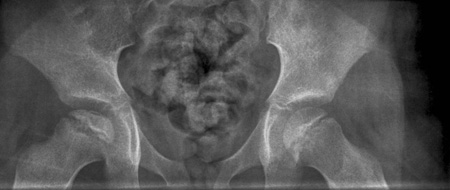შეჯამება
განსაზღვრება
ანამნეზი და გასინჯვა
ძირითადი დიაგნოსტიკური ფაქტორები
- limp
- limited range of motion at the hip joint
სხვა დიაგნოსტიკური ფაქტორები
- short stature
- muscle wasting
- hyperactivity
- Trendelenburg sign
- asymmetric limb length
- knee pain
- thigh pain
- groin/buttock pain
- synovitis
- minor trauma
რისკფაქტორები
- male sex
- age 4 to 8 years
- low socioeconomic background
- hypercoagulable states
- urban population
- race and northern latitude
- transient hip synovitis
- hip joint effusion
- passive smoking
- skeletal dysplasias
- congenital anomalies
- trisomy 21
- behavior disorders
- endocrinopathy
დიაგნოსტიკური კვლევები
1-ად შესაკვეთი გამოკვლევები
- bilateral hip x-rays
გასათვალისწინებელი კვლევები
- CBC
- serum erythrocyte sedimentation rate
- serum CRP
- bone scintigraphy
- MRI of hips
მკურნალობის ალგორითმი
with acute pain
under 5 years
5 to 7 years
over 7 years to 12 years
over 12 years
კონტრიბუტორები
ავტორები
Andrew Wainwright, FRCS (Tr & Orth) Med
Consultant Orthopaedic Surgeon
Nuffield Orthopaedic Centre
Oxford
UK
Disclosures
AW declares that he has no competing interests.
Dominique Knight, BSc, MBBS, FRCS
Consultant Paediatric Orthopaedic Surgeon
Bristol Royal Children’s Hospital
Bristol
UK
Disclosures
DK declares that she has no competing interests.
Acknowledgements
Dr Andrew Wainwright and Dr Dominique Knight would like to acknowledge Dr Jwalant S. Mehta and Dr Sandeep Hemmadi, who wrote the original topic and whose work is largely reflected in the current version. JSM and SH declared that they had no competing interests.
Peer reviewers
Phillip Thomas, FRCS (Orth)
Consultant Orthopaedic and Paediatric Orthopaedic Surgeon
Llandough Hospital
Vale of Glamorgan
UK
Disclosures
PT declares that he has no competing interests.
Young-Jo Kim, MD, PhD
Associate Professor of Orthopaedic Surgery
Children's Hospital
Boston
MA
Disclosures
Not declared.
Peer reviewer acknowledgements
BMJ Best Practice topics are updated on a rolling basis in line with developments in evidence and guidance. The peer reviewers listed here have reviewed the content at least once during the history of the topic.
Disclosures
Peer reviewer affiliations and disclosures pertain to the time of the review.
References
Key articles
Stulberg SD, Cooperman DR, Wallensten R. The natural history of Legg-Calvé-Perthes disease. J Bone Joint Surg Am. 1981 Sep;63(7):1095-108. Abstract
Catterall A. The natural history of Perthes' disease. J Bone Joint Surg Br. 1971 Feb;53(1):37-53. Abstract
Salter RB, Thompson GH. Legg-Calvé-Perthes disease. The prognostic significance of the subchondral fracture and a two-group classification of the femoral head involvement. J Bone Joint Surg Am. 1984 Apr;66(4):479-89. Abstract
Herring JA, Neustadt JB, Williams JJ, et al. The lateral pillar classification of Legg-Calvé-Perthes disease. J Pediatr Orthop. 1992 Mar-Apr;12(2):143-50. Abstract
Canale ST, D'Anca AF, Cotler JM, et al. Innominate osteotomy in Legg-Calvé-Perthes disease. J Bone Joint Surg Am. 1972 Jan;54(1):25-40. Abstract
Reference articles
A full list of sources referenced in this topic is available to users with access to all of BMJ Best Practice.

Differentials
- Septic arthritis
- Transient synovitis of the hip
- Sickle cell disease
More DifferentialsLog in or subscribe to access all of BMJ Best Practice
Use of this content is subject to our disclaimer